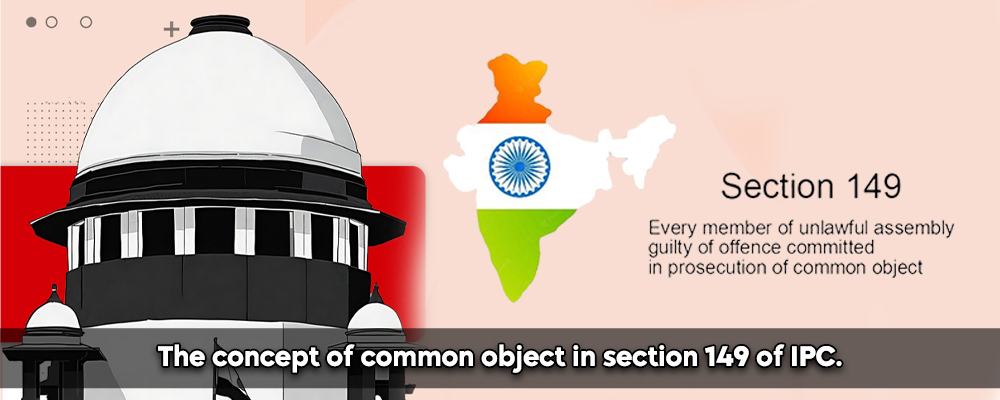It might be challenging to determine the role performed by each individual during the commission of the offense when a person is attacked by a group of people. In such situations, Section 149 may be utilized as a charge against all parties involved. The essential idea of this clause is that every person who participates in an illegal gathering with a shared purpose will be held accountable for the crime committed by the group. If they were aware that an infraction would likely be committed and actively took part in it, they would also be culpable. By holding perpetrators accountable under Section 149 under common object, this provision aims to preserve social peace and deter those who actively contribute to the commission of an attack on innocent persons.
Need A Legal Advice
The internet is not a lawyer and neither are you. Talk to a real lawyer about your legal issue

Section 149 of the IPC’s components
The following conditions must be met for a conviction under Section 149:
- There must be an illegal gathering.
- Each member of the unlawful assembly must have broken the law.
- The assembly members must either know about the offense’s occurrence or the crime must further the assembly’s common goal.
The Hon’ble Supreme Court ruled in Vijay Pandurang Thakre v. State of Maharashtra (2017) that for Section 149 to be applicable, a person must actively participate in the offense with the required criminal intent or share the unlawful assembly’s common goal. If not, the person cannot be held liable under the provisions of the said Section.
Section 149 of the IPC defines the type of offense.
At first, the Hon’ble Supreme Court held that the Section above constituted a specific and distinct offense. Lalji and Ors v. State of U.P. (1989) upheld this conclusion. But nearly three decades later, in Vinnubhai Ranchhodbhai Patel v. Rajiv Bhai Dadubhai Patel (2018), a larger bench of the Hon’ble Supreme Court of India ruled that this provision is not a separate offense but instead creates vicarious liability for all the participants with a common goal in an unlawful assembly to commit a crime. The underpinning of Section 149 is constructive liability, as many courts have noted.
Naresh @ Nehru v. State of Haryana
Fact
ASI Ram Kishan, who was on patrol duty at 75 feet road, received a telephone report that someone had shot a boy in the village of Maheshwari. Upon arriving there, a statement from Mohit @ Kala was recorded, according to which, at around 6.40 pm, his cousins Ajay and Suraj were talking in front of the home of former sarpanch Karan Singh and were close to the home of Dharmender. Further information indicated that the Bullet motorcycle was being followed by two additional motorcycles with two riders on each and batons in their hands. Additionally, it was claimed that the unidentified person riding the Bullet motorcycle got off and fired a handgun at Ajay, striking his head and causing him to fall in front of Dharmender’s home.
Judgement
The court held that to convict someone under Section 149 of the IPC, the prosecution must first show through evidence that the appellants shared a common goal and participated in an unlawful gathering, and then it must show that they were aware of the crimes that were likely to be committed to fulfill the stated goal. In Dharam Pal v. State of U.P. (1975) 2 SCC 596, the Court went into additional detail about this idea, emphasizing that vicarious guilt may be established even if there were only a small number of attackers because pre-planning and coordinated attacks were sufficient proof.
According to the report, the argument that started between Ravi and Nabbu with Ajay and Suraj on the day of Dulhandi was the suspected motivation. Ravi is also alleged to have threatened to kill Ajay. This element would make it abundantly evident that the appellants in this case were not participating in the altercation that took place on the day of Dulhandi, and as a result, no ulterior motive could be attached to the appellants. The prosecution was unable to demonstrate that the appellants in this case had a shared goal with other participants in the alleged illegal assembly.
The court concluded that there was insufficient evidence to prove that the appellants knew about the crimes that were likely to be committed to achieve their common goal, which is one of the necessary elements for conviction under section 149 of the Indian Penal Code. The appellants were not linked to the deceased or the co-accused by any evidence.A selection of legal services are offered by Lead India, including online tools and free legal advice. The best thing to do in this circumstance is to talk to a lawyer and ask a legal question.





 Talk to a Lawyer
Talk to a Lawyer